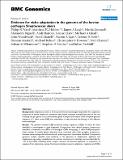Evidence for niche adaptation in the genome of the bovine pathogen Streptococcus uberis
Abstract
Background: Streptococcus uberis, a Gram positive bacterial pathogen responsible for a significant proportion of bovine mastitis in commercial dairy herds, colonises multiple body sites of the cow including the gut, genital tract and mammary gland. Comparative analysis of the complete genome sequence of S. uberis strain 0140J was undertaken to help elucidate the biology of this effective bovine pathogen. Results: The genome revealed 1,825 predicted coding sequences (CDSs) of which 62 were identified as pseudogenes or gene fragments. Comparisons with related pyogenic streptococci identified a conserved core (40%) of orthologous CDSs. Intriguingly, S. uberis 0140J displayed a lower number of mobile genetic elements when compared with other pyogenic streptococci, however bacteriophage-derived islands and a putative genomic island were identified. Comparative genomics analysis revealed most similarity to the genomes of Streptococcus agalactiae and Streptococcus equi subsp. zooepidemicus. In contrast, streptococcal orthologs were not identified for 11% of the CDSs, indicating either unique retention of ancestral sequence, or acquisition of sequence from alternative sources. Functions including transport, catabolism, regulation and CDSs encoding cell envelope proteins were over-represented in this unique gene set; a limited array of putative virulence CDSs were identified. Conclusion: S. uberis utilises nutritional flexibility derived from a diversity of metabolic options to successfully occupy a discrete ecological niche. The features observed in S. uberis are strongly suggestive of an opportunistic pathogen adapted to challenging and changing environmental parameters.
Citation
Ward , P N , Holden , M T G , Leigh , J A , Lennard , N , Bignell , A , Barron , A , Clark , L , Quail , M A , Woodward , J , Barrell , B G , Egan , S A , Field , T R , Maskell , D , Kehoe , M , Dowson , C G , Chanter , N , Whatmore , A M , Bentley , S D & Parkhill , J 2009 , ' Evidence for niche adaptation in the genome of the bovine pathogen Streptococcus uberis ' , BMC Genomics , vol. 10 , 54 . https://doi.org/10.1186/1471-2164-10-54
Publication
BMC Genomics
Status
Peer reviewed
ISSN
1471-2164Type
Journal item
Description
This work was supported by the Wellcome Trust.Collections
Items in the St Andrews Research Repository are protected by copyright, with all rights reserved, unless otherwise indicated.

